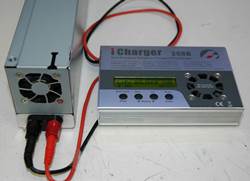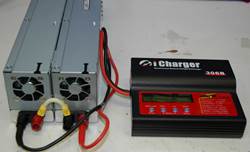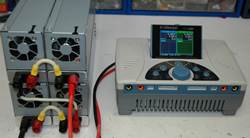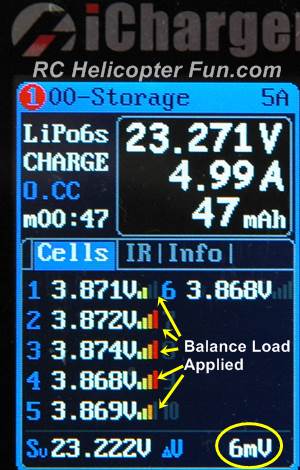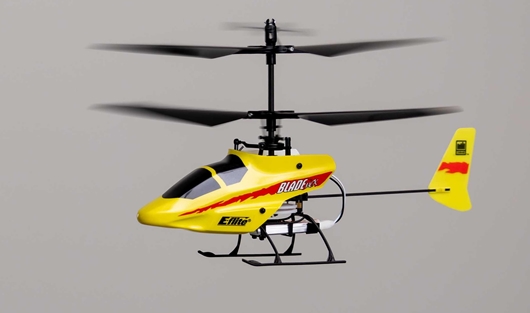RC Power Supply Basics
by John Salt - Updated September 2023
You may be thinking that my RC power supply article here is only intended for people who need ample amounts of charging power, but that is not the case.
The underlying messages of this entire write-up are focused on saving money, flexibility, and electric powered RC "growth"; from the electric powered RC newbie right up to the most experienced and power hungry RC guru.
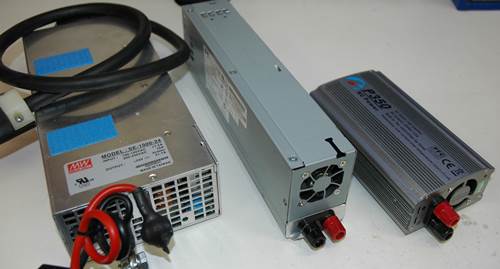 Some of my RC Power Supplies. Left to right: 24V 1000W / 12V 575W / 15V 350W.
Some of my RC Power Supplies. Left to right: 24V 1000W / 12V 575W / 15V 350W.As you'll soon see in the computer server power supply example below, I was fortunate enough to have found a wonderful and economic
power supply solution to cover this entire spectrum. I have been getting
many power supply sizing & recommendation questions lately, and I
hope this article and review helps answer most of them.
If you just quickly want to get a good quality and powerful power supply for your RC charger, Buddy RC has some very nice quality supplies for good pricing.
Getting The Right Size RC Power Supply
If however you don't know much about RC power supplies, lets go over some RC power
supply basics. If this too basic, please feel free to skip down the page right to the computer server Modular Power Supply option.
An
RC power supply is needed to power your RC battery charger/s. They convert AC voltage & current from a household outlet to
clean and steady DC voltage & current to power your RC battery
charger/s.
Some lower powered RC chargers come with built-in power supplies, but once you get past a certain charging power level, you must start using separate stand alone power supplies because of the size increase. Power supplies (PS for short) come in all sizes with different voltage and maximum current output ratings depending on your needs.
Generally, when deciding on a specific RC power supply, you pretty much have to know what RC battery charger (or chargers) you will be using with it so it's capable of providing adequate power.
The sizing rule here is if you want to get the full charging potential out of your RC charger, you must pair it with a power supply that has the same output voltage that your RC charger is rated for, along with a power output rating as high or higher than what your RC charger's maximum power rating is.
Just as an example, if you had an RC charger that was rated to run a maximum input voltage of 30V and could deliver 800W of charging power, your Power Supply should also have an output voltage of 30V (no higher) and a power rating of at minimum 800W.
My page on RC battery chargers goes over that in more detail, what to look for in a charger and how to know you are
getting a charger powerful enough for your needs now and down the road.
I
have been traveling down this electric powered road myself now for the
past 14 years since switching from nitro power to LiPo power and I've
learned two important and fundamental lessons during the journey.
1.
As you progress in electric powered RC flight or surface vehicles, your
charging needs almost always increase. This stems from the basic and
undeniable fact that as you progress with electric powered RC, you will
most certainly be getting more RC vehicles and more often than not, they
get larger at the same time. In other words not only more LiPo &
LiFe batteries to charge, but higher voltage & larger capacity ones
on top of it...
2. At
this stage, you find yourself purchasing not only more computerized
battery chargers but more powerful ones to handle the ever growing work
load for faster charging (less time charging = more time flying and
driving for more enjoyment in the hobby).
The obvious outcome as your charging needs grow, so do your powering needs. What I learned however is power supplies soon start to become one of the largest single expenses in this electric growth game.
Every time I got a new more
powerful charger, I also had to shell out at least as much or more coin
to get a more powerful RC power supply to power it! Not only that, once past the
1000 Watt realm, the RC power supply issue finally became the financial
show stopper for me in relation to the fairly reasonable price you can
get very powerful computerized RC battery chargers for these days.
Growth spurt over!
So
what's an electric powered RC'er to do? Wouldn't it be nice if you could
just increase the power (both voltage and/or amperage) of your RC power
supply the same way you could increase the memory on your computer by
simply and economically installing more memory? Well now you
can thanks to a modular computer server power supply solution.
Computer Server RC Power Supply
My converted server computer RC power supply story starts shortly after getting the iCharger 4010 Duo charger. This is a feature rich 2000 Watt power beast of a charger and as such, is hungry for clean DC power.
I was at first powering the 4010 Duo with my 1000W 24V Meanwell power supply. It worked, but I could only use the 4010 to roughly half its capacity. To get the full meal deal out of this bad boy, I needed an RC power supply that could deliver 50 VDC @ a minimum of 40 Amps and supply at least 2000 Watts of power.
I started searching for DC power supplies that could accomplish this and almost had heart failure in the process. Not only are 50 VDC 2000 plus Watt power supplies fairly rare and expensive (most well over $500), they also all needed a 240VAC power source meaning I would also have to run a dedicated 240VAC line to my charging area in the workshop - it was a huge expense that I couldn't justify (to myself or the wife)!
At this time, I was fortunate enough to get an email from a very nice fellow by the name of Mike with an RC helicopter question. During our correspondence, somehow the topic of my iCharger 4010 Duo powering dilemma came up.
Mike, as luck would have it (using his extensive electrical and computer engineering know how), had been working on a modular RC power supply system that could fill his power needs, mine, and many other RCer's at not only an affordable price, but one that could also run on a normal 120VAC supply voltage.
So What's A Modular RC Power Supply?
Simply put, you can economically and easily add multiple modified supplies together in series or in parallel to increase the output voltage, amperage, or both, exactly the same way batteries can be hooked up in series or parallel to increase the voltage and capacity. This is something you can't do with most off the shelf power supplies.
As a newbie, you can start out with one quality RC power supply very inexpensively.
Then as and if your charging needs grow or change (either
with more chargers or a more powerful one), you can just purchase and modify
additional server supplies as required, again at a very reasonable cost.
As
a more advanced electric RC'er, you can have several modified RC power supplies
all hooked together to give you one big powerful RC power supply for your
high power charger or separate them to power several smaller battery
chargers.
No one time huge RC Power Supply expense or additional huge expenses; just add or subtract power as you
need it and grow your supply power over time.
As
an advanced user, the other thing that really appeals to me is if one
of these inexpensive server power supplies fail, I'm not out of commission like I
would be if an expensive single power supply let out the "magic smoke"; I could
still charge all my batteries with the remaining good one/s, just not as
quickly.
This also makes a repair/replacement should it happen very economical. We are no longer forced into purchasing another expensive power supply, we can just purchase a single lower cost replacement one to replace the failed unit and be back at full charging capacity again.
Just a Few Modified Computer Server RC Power Supply Configuration Options:
Single 12 Volt, 47 Amp, 575 Watt, supply powering an iCharger 106B or 208B.
Two Supplies hooked in series (24V, 47A, 1150W) powering an iCharger 306B, 3010B, or Power Lab 6.
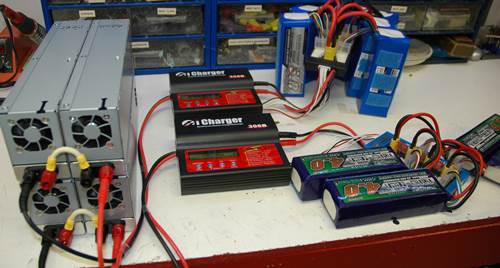
Four Supplies, two pairs hooked in series to power two iCharger 306B's or two Power Lab 6's.
Four Supplies all hooked in series (48V, 47A, 2300W) powering an iCharger 4010 Duo.
Series Configuration Calculations:
When
hooking modified computer power supplies up in series, you add the voltages and Watts
but the Amps will remain the same. For example two supplies configured
together in series will give you 24VDC @ 47A proving up to 1150W of
power.
Parallel Configuration Calculations:
When
hooking modified computer power supplies up in parallel, you add the Amps and Watts, but
the voltage will remain the same. Two supplies configured together in
parallel will therefore give you 12VDC @ 94A again providing up to 1150W
of power.
For my iCharger
4010 Duo, I have four modified computer power supplies configured together in series
giving 48V @ 47A, providing up to 2300W of power. This enables me to run
the 4010 Duo at full capacity and finally be able to para-charge twelve 6S
5000 mAh LiPo packs from a 50% storage state to fully charged in under
30 minutes - WOW!
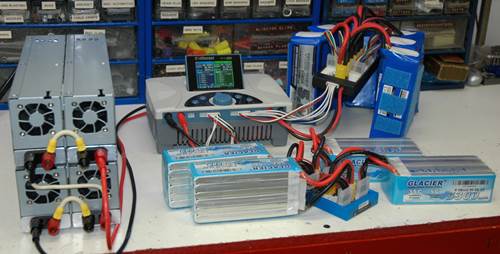
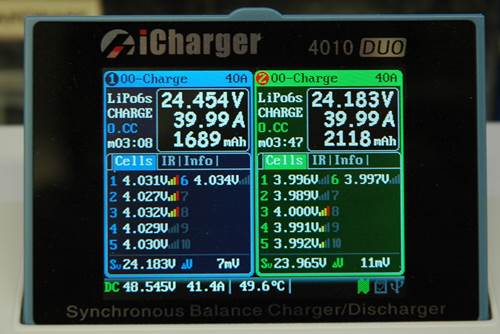 Huge RC Charging Power: 40 Amps Per Channel = 80 Amps Total.
Huge RC Charging Power: 40 Amps Per Channel = 80 Amps Total.Modified DPS 600PB RC Power Supply
These are industrial grade Hewlett Packard DPS 600PB server computer switching power supplies rated at 12VDC @ 47A providing up to 575Watts of power output.
A dual terminal (positive and negative) that will accept 1/4" fork connectors and 4mm banana plugs is then installed. The required "configurable" electrical modifications inside are performed along with the addition of a removable negative terminal chassis grounding tab (an important & necessary safety feature).
The cooling fan operation is also modified so it won't run at maximum speed all the time. Its speed is now variable dependent on internal temperature and electrical load. This makes the fan very quite in comparison to other RC power supplies I have.
Being designed for high-end computer server use, these DPS 600BP supplies can be stacked either vertically or side by side without overheating issues. To take up as little bench real-estate as possible, I have stacked mine in a 2X2 configuration.
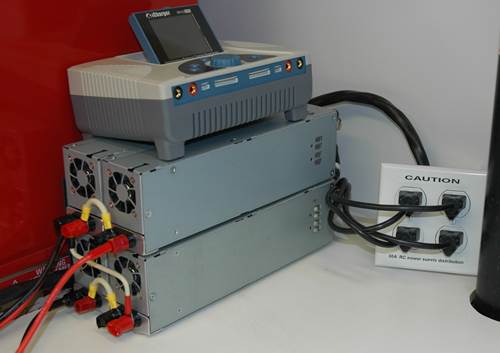
Even with them all working at near full capacity powering the 4010 Duo para-charging on both channels at 40 amps each (80 amp total), these converted server power supplies barely get warm.
Over
temperature protection is of course a standard safety feature as is
over current protection, short circuit protection, and over & under
voltage protection; making these power supplies very goof proof (perfect for yours truly).
AC Power Requirements for multiple power supply operation...
Okay, I know this is a question many people will have since I had it as well.
"How is it possible to hook four DPS 600PB power supplies together (all pulling about 575 Watts each totaling 2300W) under full load and not trip the typical 15A house circuit breaker?"
For those that didn't know
this, a 120V 15Amp house circuit can handle up to about 1440 Watts of
sustained power usage before the circuit breaker starts tripping. In
theory, the number is actually 1800 Watts (120V x 15 Amps) but electric
load calculations on typical circuit breakers are based at 80% sustained
maximum load (80% X 1800 = 1440W).
So
it's perfectly fine to plug two DPS 600PB power supplies into the same 15A
circuit and use them to full capacity as the total Wattage will be
around 1150 Watts (provided of course there are no other high Wattage
items sharing that same circuit that would push the power load
over 1440 Watts combined). A dedicated 15A receptacle on it's own
circuit is the best option if you are unsure what other items may be
sharing the circuit.
Powering 3 or more supplies...
This is were it gets a little more complicated.
Now,
I must emphasize here I'm not a licensed electrician. Moreover,
electrical codes vary from state to state and province to province. This
information is just to give you some very basic ideas of how to power 3
or more supplies. If you don't have a good working knowledge of
electricity and the residential electrical code in your particular area,
please contact a licensed electrician and they can help you out.
You
could plug three modified server power supplies at full capacity (1725W total) on a
120V 20A circuit (80% circuit breaker rule calculates out to 1920W
available). Most newer homes will have a few 20A 120V circuits. 20A
kitchen counter plugs for example are getting more and more common in
new home construction. The utility room or garage will generally have a
20A circuit as well for powering a central vacuum system.
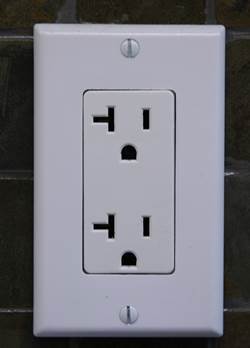 20A Duplex
20A Duplex20A 120V duplex receptacles look just like 15A ones, but the left vertical slots will also have a horizontal slot making it look like a side ways "T". It wouldn't hurt of course to check at your circuit beaker box that the 20A receptacle you plan on using is indeed controlled by a 20A circuit breaker.
I have seen a few DIY electricians install 20A receptacles on
15A circuits for example. You can' t just fire a 20A breaker in either
because 15A wiring is 14 gauge and 20A needs 12 gauge to prevent the
wiring from overheating.
The next obstacle to overcome powering three RC power supplies from a single 20A duplex receptacle is of course there are only two plug receptacles and you have three plugs from your three supplies.
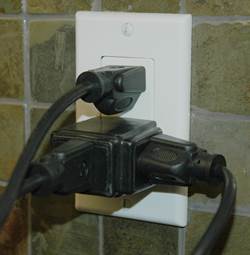
The obvious work
around is to plug one of the supplies into one of the duplex plugs, and
then use a plug expander in the other plug for the other two supplies.
A
third option would be to power two of the supplies off one 15A circuit
and the third supply off a separate 15A circuit. The potential problem
here is if one circuit breaker trips for some reason, it will cut power
to one or two of the supplies and leave the other one/s still powered
up.
This
two 15A circuit powering option will also work with four modified computer RC power supplies (two supplies hooked to one 15A circuit and the other two
hooked to another 15A circuit); but again, the potential of one breaker
tripping shutting down two of the supplies exits so it's less than
ideal.
I actually did power my four server supplies at first this way (using two separate 15A circuits) until I installed a dedicated 30A 120V receptacle in the work shop.
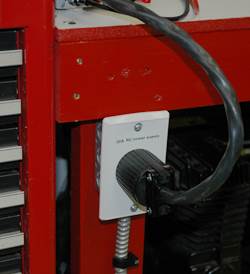
Yes, I know one of my issues with getting a 240V power supply was the expense of installing a dedicated 240V line to the workshop so how is this any different?
Well, it's slightly less expensive to run a 30A 120V line (10/2 wire instead of 10/3), and it only takes up one circuit breaker space instead of two (the main reason since our panel is pretty much full).
I then built a quad receptacle with two standard 15A duplex plugs in a 2 gang utility box. I used 30A rated 10 gauge wire with a 30A 120V twist-lock plug on the end that plugs into the new 30A twist-lock receptacle in the shop.
My quad receptacle creation here is not exactly code, but it's the workaround I came up with and is much better than powering four modded RC power supplies off two separate 15A circuits in my opinion.
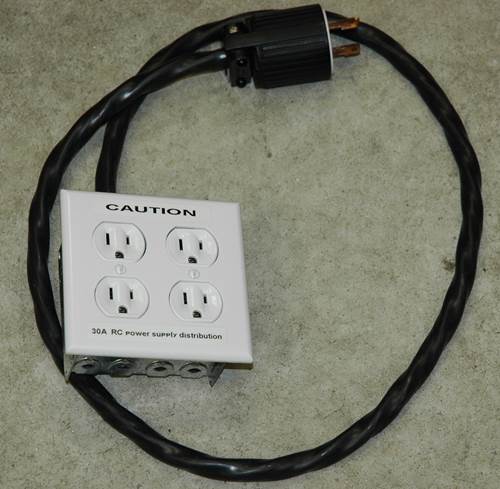
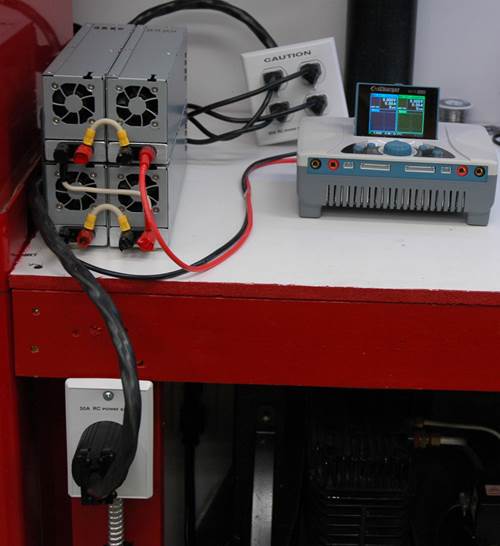
I can if I choose also plug this 30A plug and quad receptacle creation of mine into the 30A 120V outlet on the generator should I decide to take the geni out to the flying field (which I really hope I never ever have to do). May as well go back to fuel powered flight if I ever get that desperate.
Powering Computer Server Supplies with 240 VAC
These DPS 600PB supplies will of course also work on 220/240V. They automatically detect the input voltage and can run on 240V without any modifications which is pretty neat. No messing around with jumpers or hidden switches. Powering them from 240V (especially four of them) is likely a better way to do things than what I have done since you don't have to run on as high a current. Double the voltage and you effectively cut the current requirements in half (2300W divided by 240V = 9.58 Amps).
Again, this information is for enlightenment only and in no way is intended to be a "how to guide". Please seek out the services of a licensed and qualified electrician if you are not 100% sure of what you are doing when powering more than three supplies together.
Final Thoughts
Pushing aside the fact that modified server power supplies are the only modular supplies that can grow with you; they are also roughly 1/3rd the cost of similar rated RC power supplies.
Furthermore, these are industrial units designed specifically for continuous 24/7 operation in demanding server computer environments requiring higher end safety and protection features making them much more robust than simple RC grade power supplies. Put all that together and you get unmatched RC power supply value.
Lastly,
if you happen to also have an iCharger 4010 Duo or any other high power RC charger, yet want an economical way to power them; multiple inexpensive used server supplies configured in series work impressively well at about quarter the
cost of getting a huge 50V 2000W supply and you won't need a 240V source
if you don't want to go to that expense.
Those were the two main features that sold me. The quiet operation and ability to also configure them to run my less powerful chargers as well were sweet icing on the cake bonuses!
If you have a basic understanding of DC electrical principles (which most of us electric RC'ers do), and you can solder; you can modify your own computer PS with easy to source, inexpensive parts.
If however you have no interest in any of that and just want to get a good quality power supply that you can start using out of the box, be sure to check Buddy RC's RC power supply offerings; again the quality is very good for the price.
Happy Charging :-)

